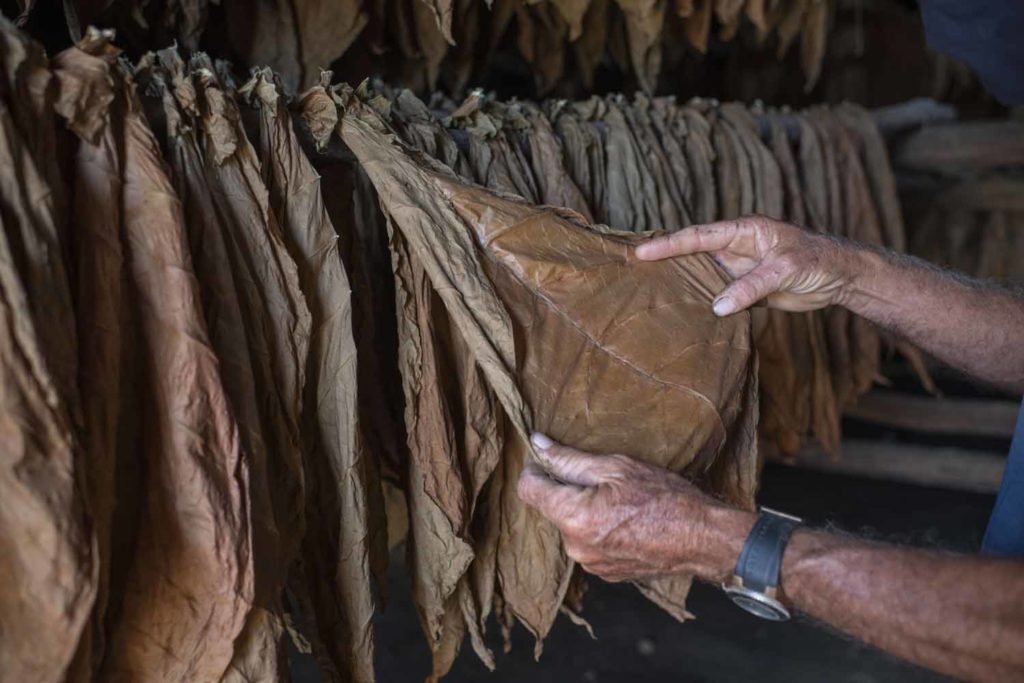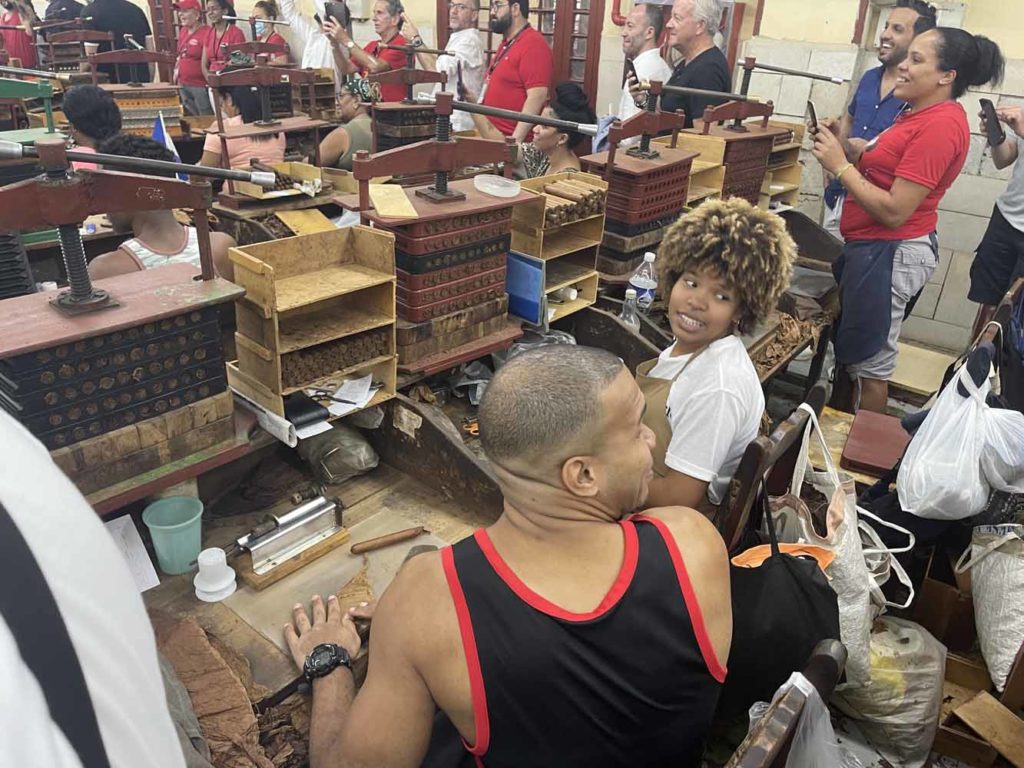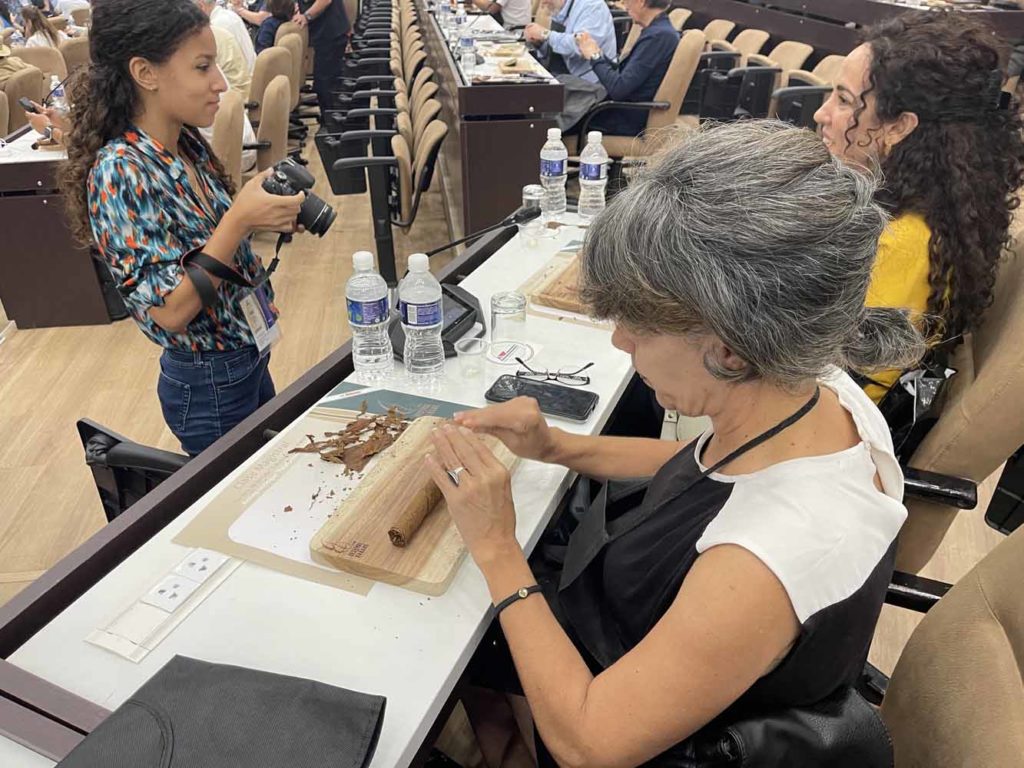Returning to Cuba
- Also in TR Cigars Print Edition
- April 1, 2023
- 0
- 14 minutes read

Credit: Timothy S. Donahue
The Cuban cigar industry is flourishing despite several challenges, including weather and factory staffing.
By Timothy S. Donahue

It was going to be a two-hour to three-hour drive. The rented 16-seat passenger bus had problems the day before, but the driver insisted that the issues had been resolved. Taking the buses provided by Habanos, the manufacturing and distribution arm of Cuba’s state-controlled cigar industry, is more reliable, but the trip often takes more than 12 hours to complete because things move at a slower pace with the Festival del Habano crowd. A small group of colleagues and I decided to rent the private bus instead.
It didn’t turn out well. About 45 minutes into the trip to Pinar del Rio, Cuba’s tobacco growing region on the western side of the island, the bus began to fill with smoke. In typical Cuban fashion, the driver turned around in his seat and said, “Do not worry; this happens all the time.” It soon became too much, however, and the bus had to pull over along the side of the busy Havana highway during morning rush hour. The six passengers climbed down the steps to the side of the road. Smoke continued to billow from the engine.
An hour after being promised another bus would arrive in 15 minutes, we decided to call it a day. We then began the hour wait for two cabs to make the short trip from the city center to pick us up during what was now extremely heavy traffic. Cuba doesn’t have much gasoline, so everything runs on diesel, and the exhaust made the roadside nearly as toxic as riding in the damaged bus. We never made it to the farms. The bus driver assured us that the bus would be fixed by the next day. We never bothered to call to find out.

Travel in Cuba can be complicated. For all of its troubles, however, the island is filled with a passion and love for everything Cuban, including its music, food and, of course, cigars. During the 23rd edition of the Habano Festival, which took place from Feb. 27 to March 3, more than 2,000 cigar aficionados from around the globe came together in Havana to celebrate the Cuban cigar after a two-year hiatus caused by the Covid-19 pandemic.
Habanos’ new co-president, Maritza Carrillo Gonzalez, said she has had the honor of attending numerous festivals and has seen for herself the passion with which Habanos enthusiasts enjoy and appreciate the event. She said she was excited for its return. “This year has a special flavor,” Gonzalez said. “This is a unique and long-awaited edition in which I take on a new position that I accept with great enthusiasm and responsibility.”
Rising from Ruin

Cuba’s tobacco farms are recovering from the damage sustained in September, when Hurricane Ian made landfall as a Category 3 storm. While Habanos brought festivalgoers to a smaller farm in Pinar del Rio, many media members wandered to other larger, more famous farms in the area. They found that the plants were still small, but farms seemed to be growing and curing plenty of tobacco leaf.
The industry intends to plant 9,500 hectares of tobacco, down from an initial plan of 15,000 ha, according to Enrique Blanco, agricultural director of Tabacuba, the agricultural arm of Cubatabaco, the state-owned tobacco conglomerate. An estimated 2,100 ha of premium shade-grown leaf will be cultivated, which Cuba hopes to use to meet its growing export demands.
In Cuba, the growing process starts in July and August, when the seedbeds are prepared, preferably on loose, well-drained soils. After 45 days of irrigation, the plants reach a height of 13 cm to 15 cm (5 inches to 6 inches) and are ready to be replanted in early October. The plants reach their full growth during the 45 days to 50 days following replanting, and after another 50 days they are ready for harvesting.
Private tobacco producers have been meeting with Cuban authorities over the past few months to secure the state’s help in settling debts and paying for materials to rebuild tobacco drying houses, according to Cubatabaco. Nicaragua and the Dominican Republic as well as other producers have also stepped in to help Cuba recuperate. Several farms have new curing barns, but many more are still needed.
Factory Floors

Entering a Cuban cigar factory can be overwhelming for the senses. The smell of cured leaf, cigar smoke and hard work can be intoxicating. During the visit to the factories this year, festival attendees had the opportunity to experience two of Cuba’s “Big Four” factories: La Corona, also once known as La Casa de Hierro, and the world-famous Real Fabrica de Tabacos Partagas. The other two major factories are H. Upmann and El Laguito. At La Corona, the factory produces Romeo y Julieta, Hoyo de Monterrey, Cuaba, Por Larranaga, Saint Luis Rey, San Cristobal de la Habana and some Montecristo. Habanos markets 27 premium brands. There are over 400 market names and an estimated 100 factory names.
La Corona’s manager said that daily production averages an estimated 25,000 cigars. Workers strip an estimated 1,200 leaf per day. During the peak of the Covid pandemic, those numbers plummeted by half. “We have returned to close to normal operations,” the manager said. “What is complicated is we had many experienced rollers leave the factory or even the country, and now we must train new rollers, and that takes time.” The manager also said that in 2022, farmers began testing a new variety of tobacco that was more resistant to fungus. “We like the results so far,” he said.
The quality control manager at La Corona claimed that the wrapper imparts little flavor to the cigar. This led to a contentious debate among festivalgoers, and the opinions varied greatly. However, when the manager insisted that the addictiveness of Cuban cigars was due not to their exquisite leaf but to the fact that their wrappers are sorted on the thighs of Cuban women, his statement went oddly uncontested.
At the Partagas factory, other brands are produced as well–everything from Partagas, Cohiba and Romeo y Julieta to Bolivar and Quai d’Orsay. The original factory closed for renovations in 2011; however, after a roof collapse in 2020, the original historic factory was shuttered for good, and all operations moved to the “new” historic building, which is still quite old.
Currently, Partagas has 200 rollers producing about 15,000 cigars a day. However, the tour guide said that on many days there are only 100 rollers or so because, like La Corona, many of them have left for other factories located closer to their homes or have left the country entirely. There is room for 240. Many rollers also switch between factories based on demand for cigars.
The exodus was evident throughout Cuba where even some well-known rollers have left the country. Reynaldo Gonzalez, for example, moved to Mexico, and the Hotel Conde de Villanueva where his La Casa del Habano (LCDH) was located is shuttered with green plywood over the entranceways. Alejandro Gonzalez Arias left the Hotel Comodoro to open a cigar lounge in California. The Comodoro store is now operated by two talented female rollers.
Robust Sales

In 2022, Habanos generated $545 million in revenue, nearly 2 percent more than in 2021. Habanos reported a turnover of $568 million in 2021 (Habanos did not define its 2022 turnover, only revenue), up 15 percent growth over the previous year. The company’s largest markets for cigar sales are Spain, France, Germany, China and Switzerland, consecutively.
The company also boosted its retail presence in 2022. Habanos now has 157 LCDH stores, 17 Cohiba Atmosphere locations, 1,264 Habanos Specialists, 2,744 Habanos Point designated stores and 587 Habanos Lounge and Habanos Terrace locations.
Last year, Habanos announced a new “global pricing standard,” which greatly increased the prices of Cuban cigars around the world. The company has already announced at least two additional price increases for 2023. The price increases have impacted the costs of Cuban cigars greatly. In 2018, for example, a box of 10 Cohiba Talisman Limited Edition 2017 cigars cost $600. Today, that same box can cost anywhere from $2,350 to $2,850—if they can be found. Cohiba Robustos were selling at multiple locations in Cuba for about $1,700 a box, meaning each cigar was selling for just under $70 each. In 2019, the box of 25 cigars was less than $300.
The company is confident in its pricing strategy, according to Jose Luis Lopez Inchaurbe, development vice president of Habanos. “The process of implementing the new price homogenization strategy takes time. As in every market, the procedures and the regulatory situations are different,” Lopez said. “So, the price increase has not been made at the same time in every market. Then we are now evaluating how the demand has been impacted by this step. In any case, it’s clear that some brands and references have responded better than others. But we see this as a normal situation of the compensation of the demand by market.”
Luis Sanchez-Harguinday, co-president of Habanos, said that the company has “big expectations” for the coming year, adding that two factors will make the most impact. “First of all, because we trust in the power of our initiatives that we have, product initiatives and other activities that we are planning for the year,” he said, “and this is a great weapon that we have, and it’s all the enthusiasm, the hard work, the spirit and passion devoted by all the participants in the value chain of our business, starting by the Cuban Tobacco Research Institute, going through the farmers, the tobacco growers, the Cuban industry, of course, the workers at Habanos, and finally, the unique and exclusive distribution network that we have.”
Evening Events

The most attended experiences during the Habano Festival are its three evening events, held on Monday, Wednesday and Friday. Each of the three evening events celebrates specific brands or releases, and the Monday opening night event commemorated the Montecristo Open line. It was held at Club Habana, a historic beach resort that opened in 1928. This year’s event featured a show with drones depicting scenes of farmers, cigar bands and cigar brand names. The event can most easily be described as a street festival on a boardwalk at the beach on the grounds of a historic resort.
Wednesday’s evening event is a little different from Monday’s event but has many of the same qualities. Held at the El Laguito Reception Hall, this experience was dedicated not only to the Bolivar marca but also to both Habanos Specialist and LCDH stores. The evening marked the release of Bolivar’s New Gold Medal cigars. This event is a giant, fancy pool party where everyone is dressed up and no one is swimming.
It was rumored that for the first time in the Habano Festival history, the company had an LCDH outlet at Monday’s evening event that was selling the newly released Open Slam. However, at the Wednesday event, participants witnessed firsthand the LCDH table selling boxes of 10 of the Bolivar New Gold Medal cigars for $250. It was a madhouse, and people waited the entire evening in some cases to buy a box of the new cigars at a seriously reduced price reserved for the festival. There is no timetable for when the cigar will be released to the public.
Friday’s gala dinner event is the premier event of the festival and is traditionally held at the Pabexpo Fairgrounds. This experience is a sight to behold. The 2023 evening paid tribute to the Partagas brand with the launch of the Linea Maestra, the brand’s most premium line. Only an estimated 1,200 people are permitted to attend. The gala was also honored by the attendance of Cuban President Miguel Diaz-Canel, who signed the Cohiba humidor for the festival’s humidor auction, bringing back an old tradition popularized by Fidel Castro during the first editions of the festival.
Castro last signed a festival humidor in 2006, when five humidors sold for a total of $725,000. It was also the final time Castro was able to attend the event. Famous for his ability to orate at length, Castro’s presence at the early events caused a mixture of awe and trepidation by some guests—awe at the opportunity to share a room with such a historical figure and apprehension about missing an early morning flight. Only a few journalists, including Tobacco Reporter, were allowed on the floor where the gala was taking place this year, as all the other journalists were relegated to platforms at the far ends of the room for nearly the entire evening.
The highlight of the closing event is the humidor auction, which has brought in record amounts of money for Cuba’s healthcare system the past few years. This year would be no different. The 2023 humidor auction generated a record $11.89 million in combined sales. This shattered the festival’s previous auction record of $4.71 million in 2020. This year, a Cohiba humidor was sold for $4.45 million, almost equaling the entire 2020 auction. It is the most expensive humidor ever sold at auction. According to sources, the buyer of the Cohiba humidor is one of the new Chinese partners of Allied Group, which owns 50 percent of Habanos.
It is impossible to truly know Cuba without visiting Cuba. For those in the cigar industry, there is no better time to travel to the country than during the Festival del Habano. For all its difficulties, it is still an amazing adventure. As one Cuban-American who has been in the tobacco industry for 35 years and was attending his first festival this year said, “It’s an amazing place. The people and the atmosphere are intoxicating. It’s also easy to see how a trip to Cuba could be going along great, and then suddenly, everything just falls apart.”

